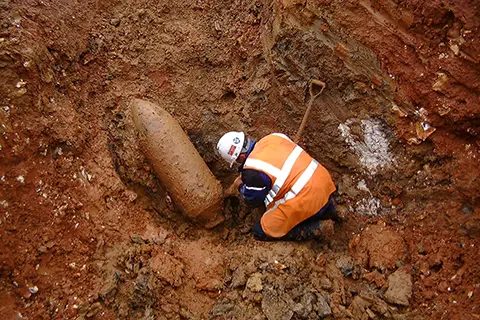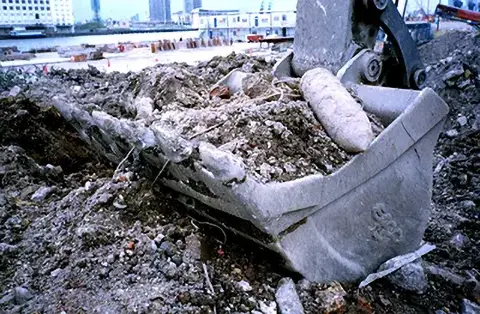Ciria C681
A complete step-by-step guide to the Ciria C681 unexploded ordnance 4 stage risk management process for constructors.
As a constructor or developer in the UK, the probability of encountering unexploded ordnance (UXO) on your site may be low. However, the consequences if you do unearth unexploded bombs, grenades or mortar rounds for example, are extremely high.
As a result of this fact, pre-planning is essential to mitigate the significant financial and safety risks.
In the UK there is no legislation defining the exact steps you have to take to ensure a site is assessed for the risk of unexploded ordnance before any excavation, construction or development work begins.
Understanding your UXO obligations according to Construction (Design and Management) Regulations
Under Construction (Design and Management) Regulations (CMDR2007) you have a legal duty to provide staff and contractors with project specific health and safety information needed to identify hazards and risks associated with the design and construction work.
The possibility of UXO being encountered on a site certainly falls within the category of a potentially significant risk. It is therefore critical that it is addressed as early as possible in the lifecycle of your project.
Taking the requirements of CMDR2007 as a starting point and building upon it with their experience and expertise, subject matter experts created Ciria C681: a guide to unexploded ordnance for the UK construction industry.
As significant contributors to the guide, under our former company name Dynasafe BACTEC, we have written this article to summarise the main points that Ciria C681 covers. It will help you quickly understand the risks that unexploded ordnance poses in Britain, and how you can overcome these risks and protect every aspect of your project – from its timeline to its bottom line, and from your staff to the environment.
The Ciria C681 risk management process
The Ciria C681 unexploded ordnance 4 stage risk management process for constructors is straightforward.
Here's a free to download flowchart for you to follow: - CIRIA flow chart
It works as follows, and Igne can help you at each stage with every aspect: -
Stage 1: a preliminary risk assessment
With Igne’s PRAs you’ll receive an assessment of your site’s risk level. The good news is, most UK sites are at low probability of encountering UXO risk. If your site falls into this category your PRA report will recommend no further action is required and you will have fulfilled your CMDR2007 obligations.
If you require multiple preliminary risk assessments, significant discount is offered.
Stage 2: a detailed risk assessment
If your site is at risk however, an in-depth desktop study should follow.
For detailed risk assessments Igne utilises archive data and specialist UXO expert information. The desktop study process includes specialist discussion and analysis of historical records including bombing maps. Consideration of site usage, construction plans and post-war development will also be included.
The process will answer the following question for you: “is the level of risk acceptable?”
If the level of risk is low and therefore acceptable, no further action will be required beyond monitoring for any future changes, e.g. if deeper excavation of a site is required at a later date. You will be able to call on Igne’s team at any time during your project should you require expert advice.
Stage 3: risk mitigation recommended
If the level of risk identified is medium to high and therefore not acceptable, Igne’s explosive ordnance experts will identify the specific UXO mitigation works required to address the unacceptable risk.
Explosive ordnance experts will produce your comprehensive risk mitigation plan. Your plan will answer the question: “is this mitigation solution viable?” If the answer is no, you may be required to revise development plans and review stage 3. The worst outcome is construction may not be viable; however, in the vast majority of cases Igne will be able to help you find viable solutions.
Stage 4: implement UXO risk mitigation plan
Once the mitigation proposal is viable, Igne's land or marine expert resources will deploy as required and complete this phase for you. If no UXO is encountered during this final phase you will receive a verification report and no further action will be required to fulfil CMDR2007 obligations.
If UXO is encountered the finding will be reviewed, the plan completed and if necessary, stage 4 will be repeated.
Free initial consultation offer
With 30 years’ experience, having delivered 20,000+ projects for over 10,000 commercial, humanitarian and governmental clients, we understand the challenges unexploded ordnance could pose to you and your project – arguably better than anyone else! Benefit from our unrivalled experience today. We offer a free initial telephone consultation to constructors and developers.
To book a call with one of our explosive ordnance disposal experts at your convenience call the commercial team on 01634 471 340 or email hello@igne.com.
Your enquiry will be prioritised, and you’ll have the opportunity to discuss your concerns and have your questions answered by a UXO expert.
Other articles of interest

What’s the value of UXO risk mitigation services?
What value do unexploded ordnance (UXO) risk mitigation services bring? What's the potential impact of UXO and who does it affect? Get all the answers to your frequently asked questions here.

Why is UXO still found in Rotherwas, Hereford?
Yesterday, a hand grenade was found in Rotherwas, Hereford. Why is unexploded ordnance (UXO) still found in Rotherwas, Hereford, over 70 years since WWII ended? Learn about Rotherwas' munitions factory, Luftwaffe bombings, and why UXO risk assessments are important for intrusive ground works.


